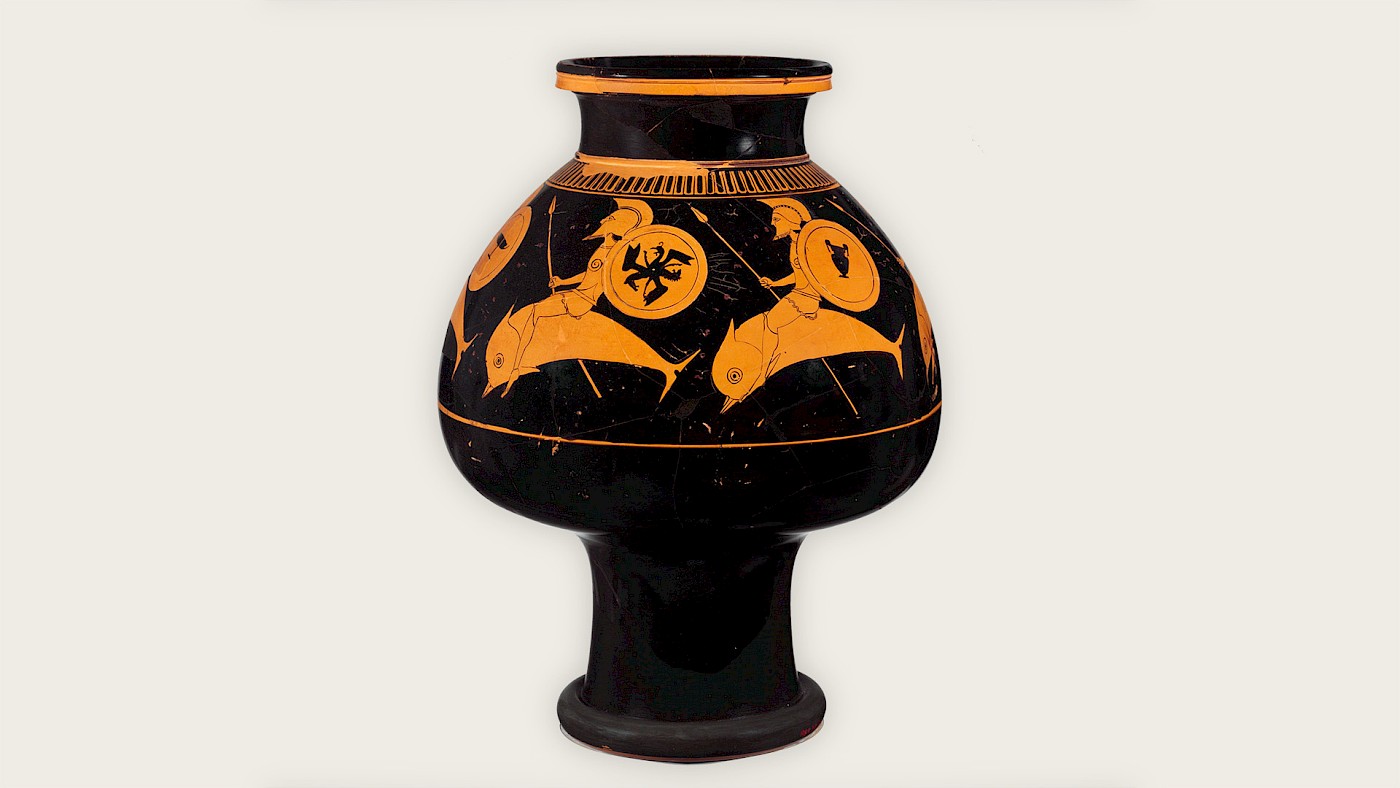The object depicted at the top of this article is a pottery vessel currently on display at the Metropolitan Museum in New York. It is a good example of early Attic red-figure art, characterized by strong silhouettes, simple linework and composition, and the effective suggestion of movement in the scene.
The object is a little over 30 cm tall, has been dated to ca. 520-510 BC, and is attributed to Oltos. As John Boardman puts it in his Athenian Red FIgure Vases: The Archaic Period (1975), Oltos “was a busy artist, known to have worked for at least six different potters” (p. 56). His name is only found on two cups, but many more vessels have been attributed to him, like this one, based on style.
This is a highly contentious subject of study, relying as it does on “connoisseurship”. This is a field where arguments are based mostly on the meticulous study of particular elements: the ways that e.g. these fingers are drawn is characterstic of painter X, and the folds on this piece of cloth are typical of painter Y. When it comes to Attic pottery, John Beazley occupies central stage: his method seems sound, his conclusions unassailable.
But when we look to pottery outside of Attica, we are presented with a different story. Anyone interested in this subject should check out the discussion on connoisseurship in Michael Shanks’s Classical Archaeology of Greece: Experiences of the Discipline (1996), pp. 30-41. Put briefly, Shanks took a sample of 164 Protocorinthian pots and then compared how these were attributed to different painters by a few major scholars. He found that “there is agreement on hardly more than one in four pots” (p. 35).
Shanks adds that “the reason for disagreement is quite clear: the connoisseurs are all doing different things” (p. 35). He concludes (ibid.):
I have used Korinthian pottery as an example here, but is there any reason to think that the results are exceptional and incidental to the practices of attribution? Some disagreement is reasonable, but it might be asked: How expert are the experts? How refined are their sensibilities? And if stylistic attribution is such a subjective exercise, on what basis have these people been authorised the luxury of cultivating and pronouncing their expert opinion?
Ultimately, who made this pot isn’t all that important. Let’s turn our attention instead to the shape. It resembles, roughly, a mushroom: scholarly literature refers to it as a psykter (from the Greek verb for “to cool”) The Metropolitan Museum says that a psykter would have been filled with wine and was then placed inside a larger krater, which was filled with ice. This way, the wine could be cooled.
Some scholars have suggested that the psykter contained the ice, rather than the wine. But in their handy book Understanding Greek Vases (2002), Andrew J. Clark, Maya Elston, and Mary Louise Hart argue that if the psykter contained the coolant, “the surrounding wine would chill more slowly; a disadvantage that makes it doubtful that this would have been the normal practice” (p. 134).
The Metropolitan Museum notes that the “dolphins would have seemed to leap and dive as the psykter bobbed in the ice water inside a large krater.” Indeed, Hart et al., in the book cited earlier, say that the shape of the psykter was ideally suited for it to float in the ice water, with “the stem acting like the keel of a boat”, though they point out that “it could stand firmly” in the base of the krater, too (p. 134).
However the psykter was used exactly, the main scene on this particular specimen depicts six armoured spearmen with shields (i.e. “hoplites”) riding dolphins. Each of the figures is followed by an inscription, epidelphinos, which means “upon the dolphin”. It is interesting that the description of the Metropolitan Museum refers to the warriors specifically as “foot soldiers”, because they are neither.
First, these warriors are clearly not advancing on foot. They are riding dolphins. Did ancient Greek city-states like Athens have a mounted force that rode dolphins out to sea? Obviously not. But the dolphins may here have taken the place of the more usual type of animal ridden to battle, namely the horse.
Images of “hoplites” riding horses are common in Archaic Greek art, to the point that I once suggested – and continue to maintain – that the Argive shield used by these warriors was specifically invented to be easy to carry on horseback. The curious thing about the warriors depicted on this psykter is not that they are depicted riding, but rather that they are not shown riding horses.
Secondly, again, these warriors are unlikely to have been “soldiers”. The word soldier derives from the (medieval) Latin soldarius, itself derived from the coin known as solidus, which was used to pay these professional fighters. In other words: a soldier is a professional warrior who fights for a salary. Ancient Greek warriors were neither professional nor did they get paid (unless they were mercenaries).
Naturally, an object like this would have been used during symposia, the drinking parties that were central to the everyday life of high-ranking men in ancient Greece. These were also the kind of men who could afford the equipment worn by the warriors on this psykter, and who themselves may have even ridden to battle.
